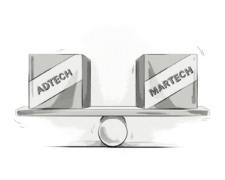The demarcation line between AdTech and MarTech has become so faint, it’s more and more difficult to tell the difference between the two, thus MadTech was born. That’s not a spelling mistake either—the need to coin a completely new term for the resulting overlap is more urgent than ever.
MadTech represents the ultimate convergence of AdTech and MarTech, which results in the most complete view of the customer across all channels.
What is MadTech?
MadTech (or MAdTech) is a term first coined by David M. Raab in 2015, which stands for the splice of marketing, advertising, and technology. The term has emerged to more accurately represent the current state of marketing and advertising technology, irreversibly intertwined and bound by data.
AdTech and MarTech have been co-existing at the opposite ends of the sales funnel, but with time it has become incredibly difficult to draw a clear line between the two. If you’re still not sure how MarTech and AdTech relate to each other, I recommend reading a comprehensive post on the Clearcode blog where we delve into the differences between the two.
Incidentally, the very fact that the differences are so muddled and need explanation is evidence of a looming, and much-needed shift in the industry.
Why Has MadTech Emerged?
It’s no accident that, when reading articles about advertising technology, we often see the terms “AdTech” and “MarTech” placed next to each other, rather than mentioned independently as completely unrelated ideas. This is because the components of one may be of little use for the modern marketer without the other.
Today, AdTech platforms are not just tools used to increase brand awareness and acquire customers. Conversely, MarTech platforms like CRMs are increasingly gaining capabilities beyond passive databases of customers, and are now run on vast amounts of data, offering social media integration, artificial intelligence, holistic profiling, and much more. This alone makes the distinction difficult.
Importantly, while the term may not sound familiar to all, MadTech is not a completely novel concept.
Within the AdTech landscape, MadTech-specific platforms have existed for some time now, and a prime example of that is the existence of data-management platforms (DMPs).
As data is the key component in both advertising and marketing campaigns, DMPs combine capabilities inherent in MarTech and AdTech, which positions the platforms in between the two realms.
For advertisers, a DMP allows them to reach new audiences (via look-alike modeling) and improve media-buying decisions during real-time bidding (RTB), whereas for marketers, a DMP enables them to craft and deliver personalized communications and offers to existing and prospective customers.
What Are the Components of MadTech?
MadTech, as its name would suggest, sits between MarTech and AdTech, and encompasses elements of marketing, advertising, and technology. To understand what MadTech is, we must grasp the role of advertising and marketing technology in the digital space.
Advertising
Advertising often involves communicating to “unknown” audiences—people who have not yet become fully aware of your products and their advantages. While you may not have detailed information about potential customers, you can still target specific audiences who are actively seeking your services or who have briefly interacted with your brand (via retargeting, for example).
However, in a post-GDPR era, collecting and using personal data, including email addresses, cookies, device IDs, and location data, is a lot harder due to the rules regarding user consent.
Advertising technology includes a number of specific technology platforms:
Demand-side platforms (DSPs) allow media buyers to run advertising campaigns and buy inventory from publishers on an impression-by-impression basis via various ad exchanges and supply-side platforms through one user interface. DSPs are a key component of the real-time bidding process, and often use data from DMPs and data brokers to optimize campaign performance—e.g. increase or decrease the bid price based on information present in the bid request.
Supply-side platforms (SSPs) help publishers sell their inventory to advertisers via a number of different ad exchanges in an automated and efficient way. Even though publishers don’t need to use an SSP to sell their inventory on the ad exchange, the technology used with SSPs provides many benefits that allow them to receive the most yield from their inventory and gain clearer insights into their audience.
An ad exchange is a platform that facilitates the buying and selling of impressions between advertisers who place their offers via DSPs and publishers who put their inventory up for sale. The process is reminiscent of stock exchanges which manage the buying and selling of stock between investors and companies.
An ad network takes a publisher’s remnant (unsold) inventory, packages it up, and offers it to advertisers on a cost-per mille (CPM) basis. Ad networks have evolved over the years and now manage premium inventory across many different verticals (e.g. automotive, travel, and finance).
An ad server is a web-based technology platform responsible for storing creatives (aka ads), making decisions about which ads to show on a website, serving them, and collecting and reporting the data (such as impressions, clicks, etc.). Ad servers are to ads what WordPress is to content.
Marketing
Traditionally, marketing is more about nurturing and communicating to known audiences. It allows marketers to create, run, and manage online marketing campaigns and conduct onsite marketing—e.g. email marketing, social-media management, A/B testing, personalization, user-feedback surveys, web analytics, etc.
Marketing technology includes the following platforms:
Web-analytics tools analyze data collected by a website or mobile app and are typically used to improve the user experience of a website, measure the performance of marketing activities, and discover how users interact with a website. These tools can include traditional platforms like Piwik PRO, or ones like Hotjar that provide different features like heat maps.
A customer relationship management (CRM) platform stores and manages a company’s interactions that they’ve had with current and potential customers. Often, a CRM will include data from various other MarTech tools, such as web analytics.
A customer-data platform (CDP) is similar to a DMP, but typically collects and stores first-party data from various MarTech platforms. With the use of a CDP, marketers can manage all their data in one place, create audiences from it, and utilize it in their marketing activities.
Social-media-management platforms like Hootsuite, Sprout Social, and Buffer allow marketers to create, schedule, and measure their social media posts and activities. Influencer marketing tools, such as TapFusion and Webfluential, as well as social-media-listening tools like Reputology and Hootsuite Insights also fall under this category.
SEO and content-optimization tools enable marketers to improve their ranking position on search engines like Google and Bing.
Personalization tools, also known as customization engines, tailor the messages of a website to match the needs and interests of individual users based on information known about them.
Search-engine marketing (SEM) platforms assist in the promotion of websites to ensure good visibility in paid search-engine results pages (SERPs).
MadTech and the Benefits of Technological Convergence
No matter which technological platform we’re considering, each involves aggregating and processing vast amounts of data.
MadTech has recently started to gain traction in response to the needs of modern marketers, and helps to combine advertising and marketing technology into one seamless category.
The result is richer data, a foundation for the most complete channel for marketers. MadTech uses programs and algorithms to target audiences with much more precision than traditional marketing and advertising (AdTech and MarTech, respectively). Thanks to this, marketers can better understand exactly what their consumers want and need by using data and technology to gain valuable insights.
The convergence of the technologies results in a number of benefits for modern marketers.
Better Insights and Streamlined Media Buying With Connection
Connection takes customer data that has been collected from a variety of places—point of sale (POS), loyalty-program interactions, e-commerce platforms, and in-store and social media interactions—combines it and takes action through digital advertising.
Informing media buys with deep customer insights helps brands get the most out of their advertising dollars. It enables marketers to establish emotional connections with customers because they can identify and engage with them at a more granular level. It’s a major step forward in a customer-engagement strategy, made possible by converged marketing and advertising technology.
It’s also worth pointing out that in this post-GDPR world where third-party data is harder to come by, using first-party data for online advertising will deliver better targeting and create a consistent user experience across devices and channels (provided the proper consent has been obtained).
Elimination of Data Silos
MarTech and AdTech are equally propelled by data. MadTech offers de-siloing and connection of a number of data sets—for example, a brand’s existing customer (first-party) data from various MarTech platforms combined with advertising-interaction data from online and offline channels, as well as third-party data.
By combining this data together and creating audiences, companies and brands can perform people-based marketing, which revolves around targeting and measuring campaigns at an individual level across any addressable channel.
In addition to a comprehensive view of the customer and more precise targeting, connected customer data also allows marketers and advertisers to better assess and measure their ad inventory, media buys, and outreach programs. Better metrics lead to more effective campaigns, which, in turn, lead to customer acquisition and revenue growth.
As evidenced above, the benefits of MadTech work two ways. Marketers have more complete insights about existing customers, and conversely, because they better know their existing customers, they can streamline targeting to new, potential customers. This reduces the cost of advertising efforts.
Conclusion
MadTech is not just another fancy term coined to further litter the overpopulated AdTech nomenclature—far from it.
MadTech only emerged to give a proper handle to tendencies that have naturally evolved for years and are increasingly common in the industry, such as the ever-increasing reliance on data and interconnectedness of marketing platforms. MadTech is not an invention; it is a mere observation of the natural evolution of marketing and its indispensable connection with advertising.








